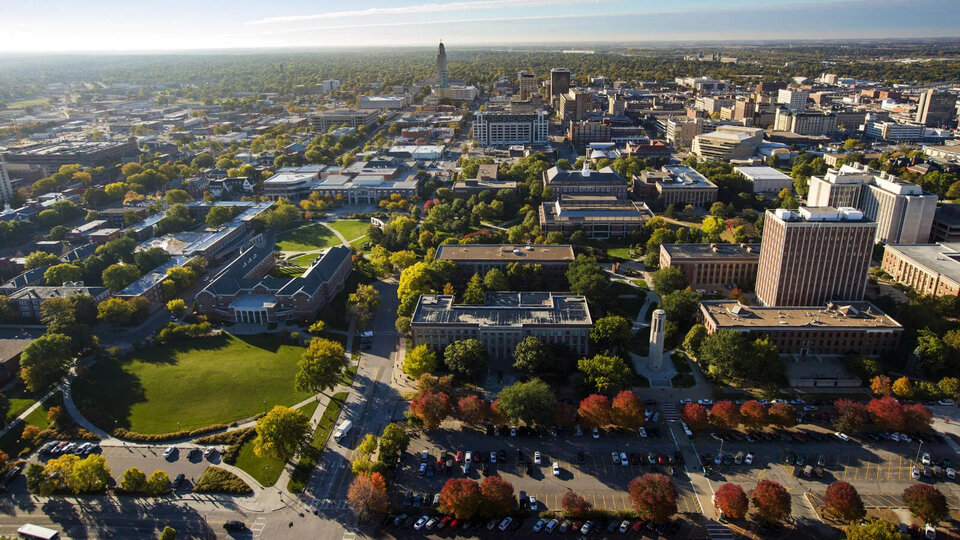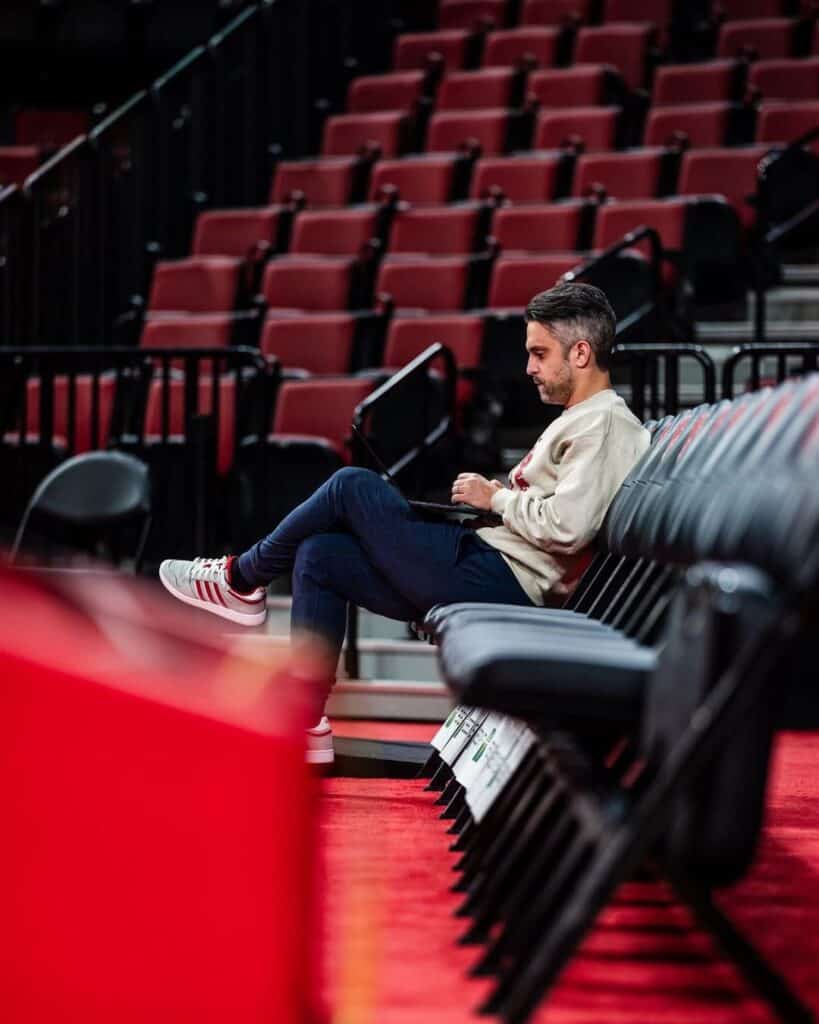The NCAA revolution seen from the inside, through the eyes of those who have to manage it: Luca Virgilio, startin from this season, is the general manager of Nebraska, the most important public university in the state located in the heart of the cold American Midwest, which competes in the prestigious Big Ten. Arriving 12 years ago from the other side of the ocean, the Roman coach now turned executive helps us understand all the difficulties of a complex world like college basketball and how a huge amount of money has changed all the rules of the game.
Here is the first part of his story, from his arrival in Lincoln to the endless phone calls to build the team coached by a great coach like Fred Hoiberg.
Together with Riccardo Fois, you are one of the few Italians who arrived in the United States not as a student-athlete but as a graduate assistant, that is, as a student-coach. How did you come to New York?
I started my sports career between Stella Azzurra in Rome and Eurohoops, which is a European scouting website. Twelve years ago, there wasn’t as much interest as there is now in recruiting young Europeans; the European basketball world was more mysterious, and only the first colleges were beginning to recruit international players. I was one of the ‘experts’ in European youth basketball, focusing on under-16 and under-18 age groups potentially eligible for college. So, I began building a network of people in Europe and at the same time started talking a lot with American colleges until St John’s offered me a graduate assistant position—let’s call it an entry-level role with a small salary but with a paid master’s degree for two years. I said yes somewhat blindly; I had the dream of working in the NBA and becoming an international scout, but it was hard to say no to New York and St John’s.
You spent five years at St John’s working mainly with Chris Mullin in a conference like the Big East. How do you assess the first part of your American career?
I was hired by Steve Lavin, and in the first year, we had a high-level team. Then Chris Mullin arrived, a global basketball legend. I had the fortune and pleasure to work with him for four years. Two years of ups and downs, then two somewhat better years; we beat Villanova twice, so we had some satisfactions. Those were very fun years, an initiation into college basketball during which I learned a lot from special people who taught me a great deal and allowed me to get to where I am today.
And now to your second stop. From two metropolises like Rome and New York, you arrived in Lincoln, deep in the Midwest. How was the transition to Nebraska?
I tell my wife that, as we keep moving west, hopefully the next place will be a bit warmer… When I was at St John’s, I used to go once a year to play against Creighton (based in Omaha, the main city in Nebraska), usually in mid-January, and the temperatures ranged between -15 and -30 degrees Celsius. Sometimes there were warnings telling you not to leave the hotel because if you went outside for 10 minutes, you’d freeze to death. Every time I went there, I thought, ‘Who would want to live in a place like this? It’s terrifying.’ Someone must have heard me… (smiles) At St John’s, I had built a great relationship with Matt Abdelmassih, an assistant coach who had worked for Fred Hoiberg at Iowa State and who Hoiberg later brought to Nebraska. They called me right after his arrival, and I came here to Lincoln, which has 300,000 inhabitants, so it’s not small, but it’s in the middle of nowhere, deep in the Midwest. However, it’s one of those places where everything is easy: no traffic, everything is a 15-minute drive, life is very good and relaxed. There’s not much to do, but if you want to focus on work, it’s hard to find a better place.

Nebraska’s campus at Lincoln
Did you manage to convince your wife in the end?
She wasn’t very happy at first; she looked at me like I had three heads: ‘So we have to move from New York, the most beautiful city in the world, to Nebraska? No way.’ But in the end, she likes it more and more, and now, with a two-year-old child, everything here is simpler and very family-friendly.
Coach Hoiberg is a pioneer, someone who saw things clearly ten years ago when at Iowa State he built rosters with transfers: what kind of person is he and what is it like working with him?
He definitely was a pioneer, also with a rather unique background: he played in the NBA, was an NBA head coach, an NBA general manager, and a college head coach, so he has such a broad background that he possesses a really extensive knowledge of basketball. Back at Iowa State, they relied heavily on transfers because it was difficult to recruit high-level young players and convince them to come there. So he created this model based largely on transfers, which worked and was then copied by everyone else up to today, with 60-70% of rosters made up of transfers. The advantage of having Hoiberg is his ability to create rosters that blend well, backed by a lot of experience.
Fred Hoiberg e Luca Virgilio
After six years as an assistant coach, you became general manager and now handle all the fundamental aspects of building and managing the team. Why this change of role?
Actually, I have always been more focused on the managerial side, and now college basketball is going through a transformation phase. For a few years, image rights can be paid, and the collegiate world is professionalizing, even though, strictly speaking, the players are not professionals. Nowadays, most college teams are creating real front offices because every spring, with the opening of the transfer portal, there is a true free agency. So having a general manager has become an essential necessity for high-level teams, since someone needs to take care exclusively of roster management. At minimum, you have 6-7 transfers, and success depends on the ability to choose the right transfers and integrate them well. Therefore, the general manager handles market management.
You have many responsibilities. Let’s go through them and help us understand how much this world is changing. Starting with recruiting: nowadays, do you find strong players only in the transfer portal, or do you also recruit from high schools and international players?
It depends; there are different categories. Today, to win in college, you usually need experienced players. It’s increasingly difficult to win with “one and done” players; you can have some top-level ones, but what John Calipari did a few years ago—building a team mostly of freshmen—is almost impossible to replicate now. In Division I, there are players aged 23-24, so even if you have an extremely talented 18-year-old, six years’ age difference matters. So, to stay competitive, “you gotta stay old,” as they say here. To stay old, you need to bring in transfers who allow you to remain competitive every year, and only then do you look at the high school market, international players, and junior colleges. Then you have to try to keep the strong players you have, which is the hardest part. So, number one: keep the strong players you have. Number two: fill the gaps with transfers. Number three: see what’s available in the international and high school markets.
That’s a huge number of players to monitor. How do you manage it?
I have a staff. As I said, you need to create a front office because when the portal opens, there are over 2,000 players inside, and you don’t just wake up in the morning and check who’s there—you already know. So it’s a year-round job: we create a database of players to follow, and then we have assistant coaches, graduate assistants, and other staff members. Together, we build this database tracking players’ growth and development.
Luca Virgilio on the field
And then you have to bring them to Lincoln. How many players did you contact to put together this year’s roster?
Many—it’s a jungle, I couldn’t even give you a number. As soon as a player’s name appears in this virtual portal, anyone can call him, and that player will receive 50 to 100 phone calls. Then you have to call the agent, then the mother, then the father, then the uncle, the aunt… so the number of calls you make is endless and nonstop, you don’t stop for a second. To succeed, you have to be clear-headed and not waste time; you only call those you really want, having a fairly wide range of options because you have to be ready to get some “no’s” and have alternative names for that type of player. We create profiles of the players we need—for example, a four who shoots from outside or a super-athletic three who defends—and based on those profiles, we have a list of 4-5 names to call. Then you have to maintain the relationship, because there’s the first call, then you go see them in person, then you have to bring them here while trying to prevent other universities from interfering and taking over. So it’s a real jungle; you have to try to gather as much information as possible and have realistic profiles of players you can actually get—Nebraska isn’t going to get Cooper Flagg, after all. You have to be realistic about your goals and value the time you have because there’s no resource more important than time.
And how do you convince players to stay—that is, to build a team trying not to change it radically from one season to the next?
The important thing is to have results, to win—that’s what matters most to most of these guys—besides the ability to turn them into professional players, whether NBA-level or high-level overseas. And then, obviously, now it’s about money, so having a significant budget that allows you to pay. It’s a job, right? You have to be competitive in three different aspects, and of course, you have to try to build a human relationship, make sure they have a good experience, and build a long-term project for them.
The coach is fundamental in all this.
Obviously, everything revolves around Hoiberg because he’s the fuel that keeps the engine running; he’s the person with all the NBA contacts. Nebraska has never been famous for sending players to the NBA, but in recent years we’ve had players drafted, players taken in the G League: Bryce McGowens was drafted, Dalano Banton was drafted, Keisei Tominaga, who is less athletic than me, signed a two-way contract with the Pacers last year and will play Summer League again, and we have three others who will play Summer League this year. So it’s an important change compared to the past. We have a lot of space here in Nebraska, we’re lucky to have some of the best training facilities in the United States, and we have the chance and fortune to have a very passionate fan base with 15,000 regular spectators, and those are things we sell a lot when we talk to players.
(CONTINUES)
